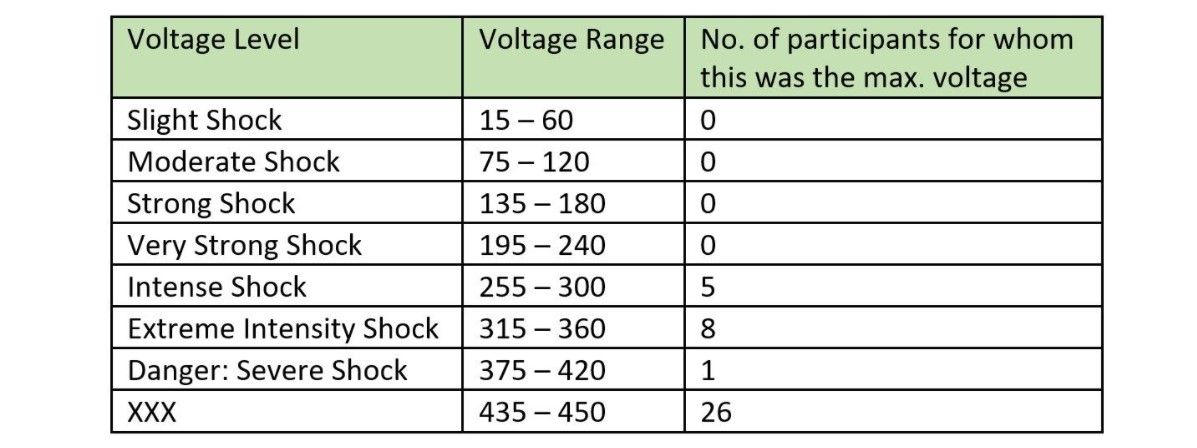Milgram (1963)
Aim To find out whether people would be obedient to authority even if it meant physically hurting others. Background 11 million people
Aim
To find out whether people would be obedient to authority even if it meant physically hurting others.
Background
11 million people were gruesomely killed by Nazis. Milgram being Jewish sought to find if anyone under a similar situation would harm or murder others under an authoritative figure's orders.
Milgram suggested a situational explanation for obedience.
Milgram had conferred with his psychology students and colleagues, and they predicted that less than 3% of participants would deliver the maximum voltage shock of 450 volts.
Research Method, Design and Stooges
Controlled observation in a laboratory setting. The study was conducted at Linsly-Chittenden Hall at Yale University.
The independent measures design was implemented.
Mr William — the experimenter was a stooge. He was a 31-year-old male school biology teacher in a coat called 'Mr William'. He wore a grey technician coat and had a stern manner.
Mr Wallace — He was a confederate/stooge, an accountant who pretended to be another participant. He was 47 years old and he played the role of 'learner'.
Sample
Volunteer or self-selecting sampling was used. A newspaper advert had been used to recruit 40 men aged between 20 and 50 years old. They were from a variety of educational backgrounds. They were from New Haven.
Procedure
Each participant was paid $4.50 for their willingness to participate. The participant was always given the role of 'teacher' and Mr Wallace the role of 'learner'. The participant was told that the study was focused on memory and learning (deception). The participant was given a mild electric shock of 45v to the wrist to convince them that the shocks were genuine. Milgram watched through a one-way mirror. The learner never received any shock, but the test shock and the elaborate machine was set up to convince the participant that they were really injuring the learner.
Memory task involved reading pairs of words aloud to the learner to test their recognition of words. Each mistake was given a voltage shock 15v higher than the previous one.
The shock generator had 30 lever switches set in a horizontal line. Shocks increased by 15 volts.

Prods
- "Please continue/please go on."
- "The experiment requires you to continue."
- "It is absolutely essential that you continue."
- "You have no other choice, you must go on."
- Prods used when the subject asks if the learner was liable to suffer permanent physical injury: "Although the shocks may be painful, there is no permanent tissue damage, so please go on." [Followed by prod 2/3/4 if necessary.]
- Prods used if the subject said that the learner did not want to go on: "Whether the learner likes it or not, you must go on until he has learned all the word pairs correctly. So please go on." [Followed by prod 2/3/4 if necessary.]
Learner
Responses were standardised. No signs of protest are heard from the learner until after the 300v shock is administered. When the 300v shock is administered, the learner pounds on the room's wall, which is heard by the subject. Learner stops responding to the questions after receiving the 300v shock. After getting the 315v shock, the pounding is repeated and afterwards, no response appears for the questions, and he is not heard from.
Teacher
Instructed to move 15v higher with each mistake and also told to announce the voltage level before administering it. The teacher is given a preliminary series of 10 words to read to the learner. 7 answers would be wrong, reaching 105v. A second list is given and is told to repeat the procedure and list until all words are memorised by the learner. When the leaner pounds on the wall, the teacher turns to the experimenter for guidance and is advised that if a response wasn't achieved within 5-10s, then to consider it as a wrong answer. Comment made: "I'm gonna chicken out... I can't do that to a man, I'll hurt his heart." Behaviour: sweating, shaking, nervous laughter, and smiling.
After the procedure ended, they showed signs of relief, wiped faces, sighed and shook heads. A small minority did not seem to be stressed. They were debriefed and interviewed and met Mr Wallace to ensure his wellbeing. As part of the interview, they were asked to rate on a scale of 0 - 14 how painful they thought the 450v shock was.
Results
- 65% of 40 participants = 26 participants went to 450v.
- 14 defiant participants stopped early: 5 after 300v; 4 after 315v; 2 after 330v; 1 each after 345v, 360v and 375v.
- The mean voltage given was 368v. The mean estimate of the pain of the 450v shock was 13.42.
Conclusions
- Situational factors that affected obedience:
- The legitimacy of the context - professional academic environment (Linsly-Chittenden Hall at Yale University).
- The feeling of financial obligation.
- Proximity to the authority figure, and the victim.
- Personal responsibility for completing the task, and momentum of compliance.
- Authority figure (appearance + sternness)
- They would not be held responsible for any damage caused.
- Individuals are much more obedient to authority than expected.
- People find that carrying out destructive acts triggers feelings of stress. This is due to a conflict between 2 important social phenomena:
i) obeying authority, and
ii) the need to avoid harming others.
Strengths and Weaknesses
- Controlled observation makes it possible to control extraneous variables in the environment such as age and appearance. Hence, the shock level administered did not depend on how sympathetic the teacher felt towards different stooges.
- The level of control and standardisation such as the same responses and prods used means that the research was more reliable.
- Detailed design of the shock generator and the test shock given increases validity because it convinced participants that the shocks were real and their actions mattered.
- The participants were all males and were from the same area. This makes results less generalisable to the target population.
- Milgram carefully selected participants to ensure a range of ages and backgrounds, which allowed the sample to have greater validity.
- An objective record of measuring the voltage levels of shocks delivered — a qualitative measurement — was taken. Results were easily comparable, and conclusions could be easily drawn.
- Qualitative measurements such as detailed information on behaviour and comments. This data is more susceptible and provides a richer understanding.
Ethical Issues
• They did not give informed consent as they were told the false aim → deception.
• Deception as the chits were rigged.
• Participants were arguably denied their right to withdraw.
• Participants underwent psychological harm and distress. There may have been lasting negative consequences as they may have been deeply disturbed by their own actions.
Application of the study
• Administrative offices - to stand up to unjust requests of bosses
• Educational institutes
• Hospitals have whistle-blowing policies to encourage the reporting of mistakes made by doctors to protect patients.
Individual and Situational Explanation
Study shows that the majority of people will be destructively obedient if they felt that the authoritative figure is legitimate. However, some individuals are more resistant to authority than others.
